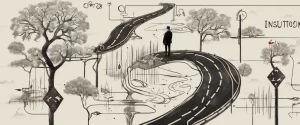
In an era marked by technological advancements and the constant pursuit of success, individuals often find themselves grappling with the overwhelming pressures of their daily lives. In an attempt to navigate this demanding world, many turn to self-help literature to seek guidance and inspiration. Two such books, The Pursuit of Perfect by Tal Ben-Shahar and “Think Like a Monk” by Jay Shetty, stand out as compelling narratives that offer unique insights into self-improvement and personal transformation. Both authors draw upon their own experiences and wisdom gained from years of research and practice, to present readers with compelling frameworks for a more fulfilling life.
The Pursuit of Perfect” offers readers an enlightening perspective on the perils of perfectionism that permeate modern society. Tal Ben-Shahar, an esteemed Harvard lecturer and positive psychologist, delves deep into the psychology behind perfectionism, highlighting its detrimental impact on one’s well-being and mental health. By sharing his personal anecdotes and engaging storytelling, Ben-Shahar challenges the conventional belief that perfection is attainable or necessary for happiness. Instead, he advocates for embracing a more realistic and holistic approach to life—one that acknowledges and accepts both our strengths and imperfections.
On the other hand, “Think Like a Monk” stands as Jay Shetty’s guiding manual on how to cultivate a monk-like mindset in an increasingly chaotic world. Drawing from his own transformative experiences as a former monk, Shetty compels readers to reflect upon their desires, relationships, and purpose in life. Embedded within his teachings are ancient Eastern philosophies and practices that offer practical guidance on how to overcome obstacles, prioritize self-care, and find peace within oneself. By urging individuals to apply intentional mindfulness to their day-to-day lives, Shetty encourages them to break free from the shackles of societal expectations and unlock their true potential.
While both books explore the pursuit of self-improvement, they diverge in their approaches and focus. Ben-Shahar’s “The Pursuit of Perfect” sheds light on the dangers of perfectionism and the importance of embracing our flaws, while Shetty’s “Think Like a Monk” offers a pathway to inner peace through ancient wisdom and self-reflection. Both authors present valuable insights into the human condition, sharing their unique perspectives on the pursuit of happiness and personal growth, ultimately guiding readers toward a more fulfilling and purpose-driven life.
Through this comparative study, we will delve further into the similarities and differences between these two thought-provoking books. By closely examining the central themes, methodologies, and underlying philosophies of “The Pursuit of Perfect” and “Think Like a Monk,” we aim to uncover the diverse approaches they offer in navigating the complexities of modern life. Ultimately, this analysis will provide readers with a comprehensive understanding of the ways in which these books can inspire and empower individuals to lead more meaningful and balanced lives.
Brief Summary of Two Books
The Pursuit of Perfect by Tal Ben-Shahar
The Pursuit of Perfect” by Tal Ben-Shahar explores the human obsession with perfection and how it can impact our well-being. The book argues that society’s emphasis on achieving perfection can lead to increased stress, anxiety, and dissatisfaction with ourselves and our lives. Through a combination of scientific research, philosophical insights, and personal anecdotes, Ben-Shahar offers a practical and holistic approach to finding happiness and fulfillment.
The book begins by examining the detrimental effects of perfectionism, such as procrastination, fear of failure, and self-criticism. It dissects the different types of perfectionism, including socially prescribed perfectionism, which is driven by others’ expectations, and self-oriented perfectionism, which is self-imposed and often perpetuated by a fear of judgment or rejection.
Ben-Shahar then introduces the concept of “optimalism” as an alternative to perfectionism. Optimalism is a mindset that emphasizes balance, growth, and learning from mistakes. It encourages individuals to set realistic goals, embrace imperfections, and value the process rather than solely focusing on the outcome. The author highlights the importance of self-compassion, gratitude, and resilience in cultivating an optimalistic mindset.
Throughout the book, Ben-Shahar incorporates practical exercises and self-reflection questions to help readers apply the principles of optimalism in their own lives. He encourages readers to redefine success on their own terms, build meaningful relationships, pursue passions, and find a healthy balance between work and leisure.
“The Pursuit of Perfect” ultimately emphasizes the importance of embracing our imperfections and finding joy and contentment in the journey towards personal growth and fulfillment, rather than constantly striving for an unattainable ideal of perfection.
Think Like a Monk by Jay Shetty
Think Like a Monk” by Jay Shetty is a self-help book that draws on the author’s experiences as a former monk and shares wisdom from ancient philosophies in order to help readers find peace, purpose, and fulfillment in their lives. Shetty explores various concepts and practices, such as gratitude, resilience, and self-discipline, and provides practical techniques to incorporate them into our modern, fast-paced lives. Through personal anecdotes, reflections, and insightful teachings, the book offers a roadmap to transform our thoughts, improve our relationships, and ultimately live a more meaningful life. Shetty emphasizes the importance of self-awareness, mindfulness, and living in alignment with our values to achieve authentic success and happiness. He encourages readers to embrace their inner monk and adopt a mindset that cultivates calmness, focus, and compassion, enabling us to navigate life’s challenges with grace. Overall, “Think Like a Monk” is a guidebook for personal growth, offering timeless wisdom and relevant advice to enhance our well-being and find purpose in today’s chaotic world.
Comparison between Two Books

Similarities in Self Help
The Pursuit of Perfect by Tal Ben-Shahar and Think Like a Monk by Jay Shetty are two self-help books that explore personal growth, well-being, and happiness. While they approach these topics from different perspectives, there are several notable similarities between the two books.
1. Focus on self-awareness: Both books emphasize the importance of self-awareness as a foundation for personal transformation. They encourage readers to understand their own thoughts, emotions, and values in order to make positive changes in their lives.
2. Mindfulness and meditation: Both authors highlight the benefits of mindfulness and meditation practices. They provide guidance on incorporating these practices into daily routines to reduce stress, enhance focus, and cultivate inner peace.
3. Embracing imperfection: Both Ben-Shahar and Shetty discuss the idea of embracing imperfection. They argue that the pursuit of perfection can be detrimental to one’s happiness and well-being, and instead advocate for accepting and embracing oneself as flawed human beings.
4. Gratitude and appreciation: Both books emphasize the importance of gratitude and appreciation in cultivating a positive mindset. They suggest that consciously focusing on what we are grateful for can greatly enhance our happiness and well-being.
5. Balancing work and personal life: The authors address the need for balance between work and personal life. They provide insights into creating a life that is aligned with one’s values and encourages readers to prioritize their well-being and relationships amidst the demands of work.
6. Finding meaning and purpose: Both books explore the concept of finding meaning and purpose in life. They encourage readers to reflect on their passions, values, and strengths to discover their true calling and live a more purposeful and fulfilling life.
In summary, The Pursuit of Perfect and Think Like a Monk share common ground when it comes to self-help topics. They both emphasize self-awareness, mindfulness, the acceptance of imperfection, gratitude, work-life balance, and the search for meaning and purpose. By delving into these similarities, readers can gain valuable insights and tools for personal growth and well-being.
Divergences in Self Help
The Pursuit of Perfect by Tal Ben-Shahar and Think Like a Monk by Jay Shetty are both self-help books that aim to guide individuals towards personal growth, fulfillment, and happiness. While they share similarities in their overall goals, there are significant divergences in terms of their approach, philosophical foundations, and practical techniques.
In terms of approach, The Pursuit of Perfect focuses on finding balance in one’s life rather than striving for unattainable perfection. Ben-Shahar emphasizes the importance of accepting imperfections and embracing the concept of “optimalism” – the pursuit of one’s best self rather than an idealized version. The book provides strategies and practical exercises to help cultivate this balanced approach.
On the other hand, Think Like a Monk delves deeply into the teachings and practices of mindfulness and meditation, drawing on Shetty’s experience as a former monk. Shetty emphasizes the need for individuals to cultivate a monk-like mindset to find inner peace and joy. He provides readers with a step-by-step process to develop mindfulness, gratitude, and purpose in life.
In terms of philosophical foundations, The Pursuit of Perfect draws heavily from positive psychology, focusing on enhancing well-being through developing strengths, cultivating gratitude, and pursuing meaningful goals. Ben-Shahar explores the concept of happiness and suggests various techniques for achieving it, such as practicing self-compassion and creating a healthy work-life balance.
Think Like a Monk, on the other hand, infuses ancient Eastern philosophies and ideologies into its teachings. Jay Shetty combines wisdom from Buddhism, Hinduism, and other spiritual traditions to guide readers towards self-awareness, emotional resilience, and greater clarity of purpose. The book places a strong emphasis on personal transformation and the role of spirituality in finding fulfillment.
In terms of practical techniques, The Pursuit of Perfect focuses on providing readers with research-backed strategies for overcoming perfectionism, embracing failure, and establishing healthier habits. It offers reflection exercises, goal setting techniques, and tools to navigate the pressures of modern life.
Meanwhile, Think Like a Monk offers a holistic approach to personal growth, highlighting the importance of integrating mindfulness and meditation in daily life. It provides specific meditation practices, journaling prompts, and visualization exercises that draw from Shetty’s monastic training while adapting them to the context of everyday existence.
In summary, while The Pursuit of Perfect and Think Like a Monk both fall under the self-help genre, they diverge in their approach, philosophical foundations, and practical techniques. Ben-Shahar’s book focuses on finding balance and embracing imperfections, while Shetty’s work delves into ancient wisdom and spiritual practices. Consequently, readers with varying preferences and needs may resonate more with one approach over the other.

Conclusion
Both “The Pursuit of Perfect” by Tal Ben-Shahar and “Think Like a Monk” by Jay Shetty are highly recommended books and offer valuable insights. The choice between the two ultimately depends on your personal interests and what you are seeking from a book.
“The Pursuit of Perfect” focuses on finding happiness and success by letting go of the need for perfection. It delves into the idea that authenticity and embracing imperfections is a key aspect of leading a fulfilling life. If you are looking to explore the concept of perfectionism and its impact on well-being, this book could be a great choice.
On the other hand, “Think Like a Monk” presents philosophical and practical guidance for achieving inner peace and leading a purposeful life. Jay Shetty, drawing from his experience as a monk, offers insightful advice on cultivating mindfulness, overcoming negative thoughts, and finding your purpose. If you are interested in mindfulness, spirituality, and personal growth, this book may resonate with you.
Ultimately, the choice between the two books depends on your personal preferences. It may be beneficial to read reviews or summaries of both books to get a better understanding of the specific topics they cover, and choose the one that seems more aligned with what you are seeking at the moment.



